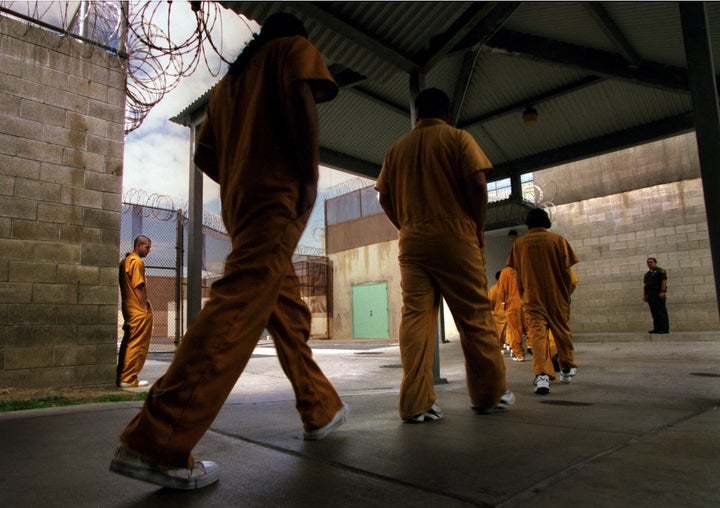
LOS ANGELES ― For the past three years, the Orange County District Attorney’s Office and the Orange County Sheriff’s Department have been embroiled in a sprawling jailhouse informant scandal ― one that may have involved the violation of multiple defendants’ civil rights, and that threatens to upend a number of already settled cases.
The U.S. Department of Justice, though, is still weighing whether to take federal action.
“The Justice Department is aware of the allegations involving the Orange County District Attorney’s Office and Sheriff’s Department, and we are assessing them to determine whether federal action is warranted,” a DOJ spokesman told The Huffington Post.
The department declined to comment on multiple questions regarding the county’s jailhouse informant program, which is alleged to have violated defendants’ rights for decades.
It also declined to comment on questions related to what is understood to be an ongoing investigation into the county’s jail system stemming from the brutal 2006 killing of prisoner John Derek Chamberlain, who was beaten to death by fellow inmates while a guard watched the television show “Cops” nearby.
Orange County is the third largest county in California by population, and the reverberations from the scandal there have already been felt by state lawmakers, who recently passed a law that could send cheating prosecutors to jail.
Still, the U.S. Justice Department has been largely silent on the situation since July 2015, when the Orange County Register obtained and reported on an email from Christopher Cheng, a DOJ attorney. In that email, Cheng wrote that the department’s civil rights division, while still investigating the county’s jail system, was also “keeping an eye” on the numerous allegations of misconduct from prosecutors and police involving the use of jail informants in the county.
Since then, more evidence and allegations of misconduct have piled up. And legal experts are wondering why the feds, thus far, have refused to intervene.
The Jailhouse Informant Scandal
In mid-2014, Superior Court Judge Thomas Goethals permitted a second round of hearings regarding jailhouse informant evidence the case of Scott Dekraai, a man who shot and killed eight people in 2011 in the deadliest mass murder in Orange County history.
Goethals’ decision came after Assistant Public Defender Scott Sanders discovered that the county sheriff’s department had been documenting the movements of jail inmates and informants for at least two decades ― but had kept those records concealed.
The records showed that at least two sheriff’s deputies had either “either intentionally lied or willfully withheld information” from the court during the Dekraai proceedings, Goethals said in a ruling. The judge also admonished the district attorney’s office for failing to turn over the computerized records after almost two years, despite repeated court orders to produce them. Even if this was unintentional, the judge ruled, it was still a “serious discovery violation.”
The deception was so significant that in early 2015, Goethals booted the entire district attorney’s office from the remaining proceedings in the Dekraai case.
Another bombshell came in early 2016, when an 1,157-page secret database surfaced ― a log that was maintained by sheriff’s deputies who work in a branch of the department called Special Handling, which specifically deals with inmates and jail informants. The database, which described years’ worth of interactions with inmates and informants, shed new light on the scope of the informant program in the county.
Once this database was discovered, the district attorney’s office finally acknowledged ― after years of denials ― that, yes, an informant program does indeed exist, and sheriff’s deputies had actively “recruited and utilized” informants and rewarded them in exchange for information.
The DA’s office also admitted that the log contradicts statements made by multiple witnesses, including several members of law enforcement in the county, who’d testified during hearings in the Dekraai case.
However, Sanders argues that the deception goes well beyond deputies in the jail. He contends that it points toward a cover-up that extends far up the chain of command. The sheriff’s department has denied that any command staff knew about the log prior to 2016 ― even though Sanders cites evidence that at least one commander, a man named Jon Briggs, had previously served as supervisor of the Special Handling deputies for a period when the secret log was operational.
Sanders should have received a copy of the log years ago, when a court ordered the Orange County Sheriff’s Department to turn over just this kind of material. Indeed, Goethals blasted OC Sheriff Sandra Hutchens in court last month for the lengthy delay in turning over the log. And the mystery surrounding the database continues: Lt. Mark Stichter, spokesman for the OCSD, told HuffPost recently that the agency is still trying to determine why the log ended.
In court, Goethals questioned Deputy County Counsel Elizabeth Pejeau, who represents the sheriff’s department, about the highly suspicious timing of the log’s final entry in 2013 — made just six days after Goethals ordered the prosecution to hand over thousands of pages of documents to Sanders about the informant who has been at the center of the scandal. Goethals also pressed Pejeau on the sheriff’s department’s claim that it is still, nearly six months after the most recent revelations, unable to say whether a new log replaced the one ending in 2013.
Meanwhile, the sheriff’s department continues to deny that a formal jail informant program even exists ― despite evidence, like the 1,157-page log itself, that would seemingly make such denials impossible.
Sanders alleges that in multiple Orange County cases, informants held recorded and unrecorded conversations with inmates who were already represented by lawyers. This would be a violation of an inmate’s right to counsel.
Prosecutors then allegedly took damning evidence gathered by the informants and presented it in court, while withholding evidence that could have been beneficial to the defense — a move that would violate a defendant’s right to due process.
Sanders’ discoveries have caused multiple murder cases in the county to unravel, with some accused murderers even having their sentences vacated.
It remains unclear exactly how many cases in the county may have been affected by tainted informant evidence, but Sanders has argued that every case involving a jailhouse informant in Orange County over the last 30 years deserves to be re-examined.

The Investigation Into The Jail Death Of John Chamberlain
In recent court documents, Sanders has brought up the killing of John Chamberlain ― a prisoner in Orange, California, who was beaten to death by fellow inmates on Oct. 5, 2006 ― and raised serious questions about the integrity of the OCDA and OCSD investigation of it.
Chamberlain, 41, was awaiting trial on a misdemeanor charge of possession of child pornography when he was killed. The investigation that followed his death, Sanders says, was remarkably similar in some ways to the current jailhouse informant scandal, in terms of evidence disclosure and concealment. Sanders is also critical of a culture that he says has allowed government authorities to believe they can conceal evidence and lie with impunity.
In 2007, OCDA issued a blistering investigative grand jury report describing misconduct on the part of the sheriff’s department in the Chamberlain case. The report accused OCSD of violating county protocols and longstanding norms around homicide investigations. It also demonstrated that witnesses from the sheriff’s department had provided false testimony and that the department had failed to turn over requested evidence.
In one particularly revealing passage of the report, the grand jury said that its nine-month investigation was slowed and its objective, at times, was hindered by “delays and lapses” in OCSD’s compliance with the grand jury’s orders for evidence ― issues similar to what Sanders and Goethals are still confronting nearly a decade later.
“Material records sought during the Grand Jury’s inquest were never produced and remained inexplicably missing, while others necessitated multiple orders before their eventual delivery,” the report reads. “A substantial bulk of documentary evidence was extensively redacted, obliterating relevant content, while other records were presented by witnesses unqualified to testify to their production.”
But despite these and other findings ― including that sheriff’s department personnel committed perjury and engaged in extensive efforts to deprive the grand jury of evidence ― the district attorney’s office specifically declined to file charges against any member of law enforcement. The DA’s office argued that while the behavior of some members of the sheriff’s department could be described as negligent and even reprehensible, it nevertheless had not risen to a criminal level or altered the course of the grand jury investigation.
This argument didn’t make sense to everyone. Laurie Levenson, a professor at Loyola Law School who in 2015 was part of an OCDA-selected committee examining the conduct of the district attorney’s office in the aftermath of the jailhouse informant scandal, questioned the OCDA’s claim in 2008 that the lies were somehow irrelevant to the full investigation.
“The standard for materiality is extremely low,” she said, according to the OC Register. “Maybe if they lied about what they had for lunch... that would be immaterial. But everything else would seem to be material.”
Further, Sanders says that both the district attorney’s office and the sheriff’s department hid important evidence from nine murder defendants ― and from the trial judge, the California Court of Appeal and likely the U.S. Department of Justice ― regarding evidence pertinent to the believability and bias of the lead investigator in the Chamberlain killing. Further muddying the death investigation, Sanders says, is the fact that OCSD investigated the jail death itself, violating decades-old protocol designed to protect against conflicts of interest. In the previous 129 deaths that occurred in custody in Orange County, the district attorney’s office had investigated, not the sheriff’s department.
Speaking out on the potential consequences of this conflict, Marvin Ellenbecker, the foreman of the grand jury, wrote in a 2008 letter to the chairman of the county board of supervisors that the sheriff’s department “inexplicably insisted on leading this particular investigation” and that “it may never be known what, if any, impact this action had on the results of the homicide investigation.”
According to Sanders, members of the district attorney’s office and the sheriff’s department — unlike the grand jurors — were not in the dark about the effects of an OCSD-led investigation. However, staff from both agencies elected to hold back evidence about Ken Hoffman, OCSD’s lead investigator into Chamberlain’s death. That evidence, Sanders argues, would have damaged Hoffman’s credibility and raised significant questions about his motivation to protect fellow deputies from being implicated in the killing.
In a recent 185-page brief, Sanders describes how Hoffman had previously been the subject of an intense internal inquiry following allegations of misconduct in his investigation of a special circumstances homicide, allegations that were first raised by investigators from the Vancouver Police Department. As a result of the OCSD’s investigation of Hoffman, he was temporarily transferred out of the homicide unit ― a point he did not acknowledge during his testimony in the Chamberlain murder trial. According to Sanders, the concealment of Hoffman’s transfer, as well as other evidence about his earlier misconduct, would have damaged Hoffman’s credibility and undermined any notion that he was truly exploring the wrongdoing of his fellow Sheriff’s deputies related to Chamberlain’s death.
In court documents, the OCDA dismissed all of Sanders’ allegations in the Chamberlain case, calling them “misguided and unfounded.”

Still, The Feds Have Not Intervened
The DOJ’s continued inaction in Orange County, despite the mountain of evidence, allegations and questionable behavior by prosecutors and law enforcement there, has many legal experts scratching their heads.
“I find the DOJ’s indecision rather baffling,” Daniel Medwed, a law professor at Northeastern University who has written at length about prosecutorial misconduct, told HuffPost in an email. “Both the breadth of the scandal (the number of informants and government officials potentially involved) and the depth (touching upon capital and other serious cases) cry out for federal intervention in my view, especially in light of the less than vigorous state level response so far.”
The California Attorney General’s office launched an investigation into the allegations against county prosecutors and law enforcement last year. The detail of that investigation have not been made public.
When a pattern of civil rights violations emerges from a law agency, the DOJ is legally capable of attempting to compel that agency to change its corrupt ways through a consent decree, generally under the threat of a federal civil rights lawsuit if the agency does not comply. DOJ has taken such action against multiple agencies, from police departments to jails. Recently, the feds intervened in Ferguson, Missouri, with the aim of ending unconstitutional practices in the city’s courts and police department that had helped spark unrest in the St. Louis suburb following the police killing of Michael Brown in 2014.
Multiple legal experts have repeatedly called for the DOJ to use those powers to conduct a full investigation of the OCDA’s office and the OCSD regarding the informant program. Even Orange County District Attorney Tony Rackauckas, who has maintained that no one in his office intentionally behaved inappropriately with regard to the jailhouse informant program, has invited the DOJ to investigate his office’s practices in that area.
Alexandra Natapoff, professor and associate dean of research at Loyola Law School, says the arguments for federal intervention in Orange County have only grown stronger over the years.
“Orange County presents an important opportunity for the Department of Justice, not only to intervene in one of the greatest snitch scandals in U.S criminal justice history, but also to set an example on an issue that has plagued jurisdictions and cases around the country for many decades ― the issue of law enforcement and prosecutorial disclosure,” said Natapoff, who has written extensively about informants.
Natapoff cited a 2009 federal case against former Sen. Ted Stevens (R-Alaska), who was convicted for concealing gifts he had received while in office. When it came to light that federal prosecutors in that case had hidden evidence that they should have turned over to Stevens’ defense team, the conviction was thrown out by then-Attorney General Eric Holder.
Holder, in essence, concluded that upholding the Constitution was more important than protecting the conviction of his prosecutors. That’s the kind of message that needs to be sent not just to Orange County, but to prosecutors’ offices and sheriff’s departments around the nation ― and the Justice Department is the ideal agency to send it, Natapoff said.
“The constitutional obligation of the prosecution to share information that is favorable to a defendant is the primary bulwark that we have ― the most important tool that the Supreme Court has given us for ensuring both the integrity of convictions and their accuracy,” Natapoff said. “Without that, we’re at sea.”
